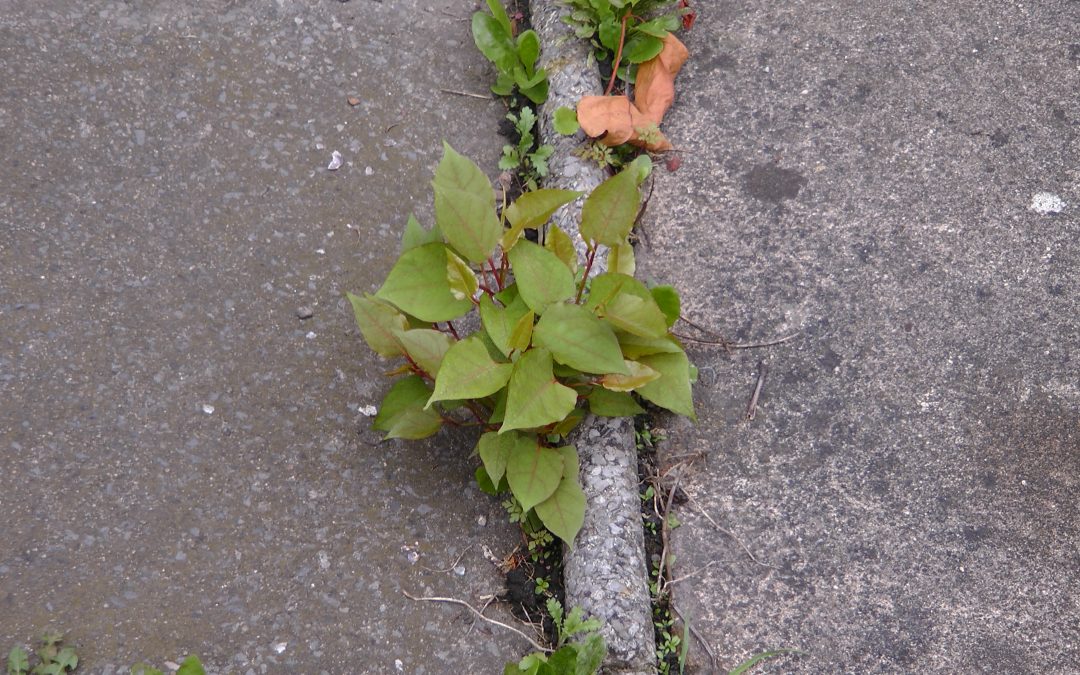Can you concrete over Japanese knotweed?
In the UK, concreting over Japanese knotweed is generally not recommended as a standalone solution for controlling the plant. Japanese knotweed has an extensive and resilient root system (rhizomes) that can penetrate through badly laid concrete and cause damage to structures over time. Using concrete alone to cover Japanese knotweed will not eradicate the plant, and it may even exacerbate the problem by providing the plant with an opportunity to grow and spread beneath the concrete.
Here is why concreting over Japanese knotweed is really not advisable:
- Ineffective control: Japanese knotweed is known for its ability to push through and break concrete and other hard surfaces. The plant’s rhizomes can extend deep into the ground, and concrete alone cannot prevent its regrowth.
- Structural damage: As Japanese knotweed continues to grow beneath the concrete, its rhizomes can exert pressure on the concrete, leading to cracks and structural damage, which could be costly to repair.
- Legal obligations: Attempting to cover Japanese knotweed without proper control measures may lead to unintentional spread to neighbouring properties or natural areas, which is illegal under the Wildlife and Countryside Act 1981.
Japanese knotweed on your property
If you have Japanese knotweed on your property, it is essential to seek professional advice from an invasive species specialist or a reputable Japanese knotweed removal company. They can develop a tailored management plan to effectively control and eradicate the plant, ensuring that it does not cause further damage or spread to other areas.
Using a combination of appropriate control methods, such as herbicides, excavation, or burial, along with ongoing monitoring and maintenance, is usually the most effective approach for dealing with Japanese knotweed infestations in the UK. Always ensure that any actions taken to manage Japanese knotweed comply with UK laws and regulations related to invasive species control.
When choosing a company to handle your Japanese knotweed problem, it’s essential to do thorough research and consider the following factors:
- Reputation and reviews: Look for reviews and testimonials from previous customers to gauge the company’s track record and customer satisfaction.
- Accreditation and certifications: Check if the company has relevant certifications or memberships with recognized trade bodies related to invasive species management.
- Experience and expertise: Ensure that the company has experience in dealing with Japanese knotweed and can provide evidence of successful projects.
- Guarantees and warranties: Inquire about any guarantees or warranties offered by the company for their services.
- Cost: Obtain multiple quotes from different companies to compare prices and services offered.
- Insurance: Check if the company has appropriate insurance coverage for their work.
- Licensing and compliance: Ensure that the company adheres to all relevant laws and regulations regarding invasive species management.
Before making a decision, consider getting a consultation from multiple companies to assess their approach to dealing with the Japanese knotweed problem on your property. A reputable company will provide you with a comprehensive survey and management plan tailored to your specific situation.
Understanding the Burial of Japanese Knotweed in UK Landfill Sites
The Legal Framework Governing Japanese Knotweed Disposal In the UK, the disposal of Japanese Knotweed is strictly regulated. Under the Environmental Protection Act 1990 and the Wildlife and Countryside Act 1981, it is illegal to spread or allow the spread of this invasive plant. Consequently, proper disposal methods, like landfill burial, are crucial.
The Process of Burying Japanese Knotweed Burying Japanese Knotweed in landfills is a meticulous process. It begins with a careful assessment of the infested site, followed by the excavation of the plant, ensuring all rhizomes are removed. The waste is then securely packaged, typically in robust, impenetrable materials, to prevent any escape during transit. Upon reaching a designated landfill, it’s buried deep underground, following specific guidelines to prevent any regrowth.
Environmental Implications of Burial The decision to bury Japanese Knotweed carries significant environmental considerations. The primary goal is containment; however, concerns regarding long-term impacts on soil quality and local ecosystems are prevalent. The contained area must be monitored to ensure the plant does not breach its confines.
